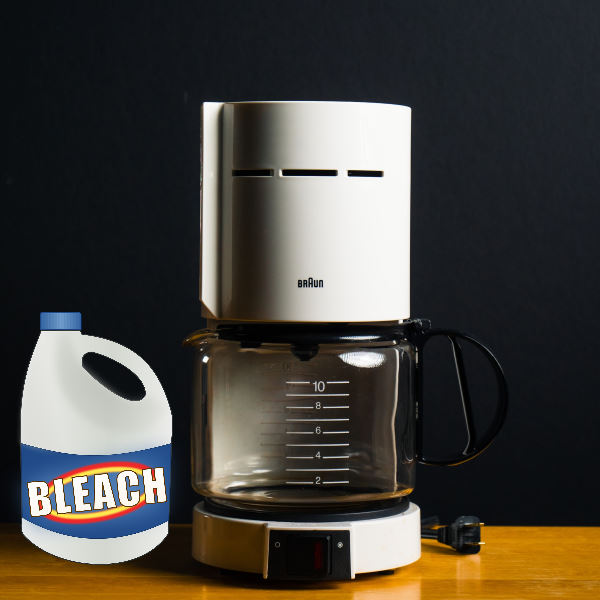
There’s nothing like starting your day with a steaming cup of Joe.
You may think about your next coffee fix often but have you thought about cleaning your coffee maker?
Your coffee machine is home to several bacteria and germs due to the hot and moist environment.
Cleaning it regularly will help to enhance the flavor of the coffee while keeping you healthy.
But can you clean it with bleach?
Cleaning Overkill
Cleaning the outside of the coffee maker with bleach is about as far as you should go.
While a good disinfectant, there are plenty of cons to using it.
Inhaling the fumes can be dangerous to your lungs, cause lightheadedness and, irritate your eyes and nose.
Since you’ll need to clean the insides of the coffee maker, it’s best to keep bleach out of anything you would eat or drink.
The last thing you’d ever want to do is ingest even a small amount.
Luckily, there are plenty of other nontoxic alternatives that will allow you to disinfect the inside.
How to Clean a Coffee Maker With Bleach
If you’re really determined to clean your precious machine with bleach, start with the carafe.
Step 1
It may be best to take your carafe outside since bleach can have a powerful scent.
- Pour some bleach into the carafe, mix with water and swirl it around
- Let sit for up to an hour
Step 2
- When the time is up, wash the carafe out with warm water
- Use dishwashing detergent to clean out the rest of the bleach
- Let it air dry
Now you have a completely disinfected carafe to enjoy your morning java.
Step 3
- Mix 3 or 4 parts water with 1 part bleach in a bucket or large bowl
- Use either a sponge or rag and dip into the mixture while wearing gloves
- Clean all around the coffee maker, removing months of germs and grime.
While cleaning the outside of the coffee maker with bleach is effective, it’s important to follow the appropriate steps.
Diluting with water is the most effective way to use bleach as a cleaner.
It is important to note that mixing with other household cleaners, like ammonia, can result in the release of toxic gas.
Cleaning the outside of the coffee maker and the carafe with bleach is the most that should be done. It’s not recommended to brew a cycle with a water/bleach mixture. There are plenty of other nontoxic alternatives for this!
Cleaning The Insides
As mentioned earlier, bleach can be a great disinfectant.
The outside of the coffee maker and carafe will be sparkling clean and germ free after scrubbing with some Clorox.
However, there are so many other safer and just as effective options to clean the insides of a coffee maker. Here’s a quick mention of the most common ones.
Vinegar
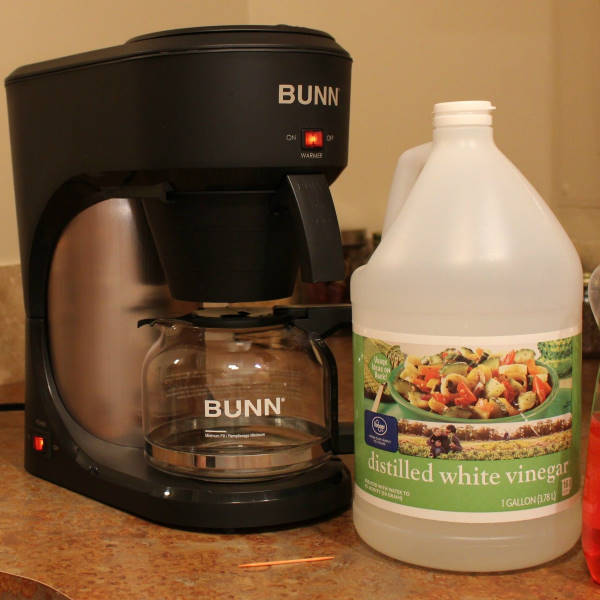
Cleaning with vinegar is a wonderful alternative to bleach.
Its acidity helps remove buildup and is, in general, a great disinfectant.
It’s also a popular choice as it’s a part of every kitchen.
- Fill the reservoir with a mixture of 2 parts water to 1 part vinegar
- Brew as if you’re preparing your favorite coffee
- Pause the brewing process about halfway through and let it sit for up to a half-hour
- Continue brewing
- Repeat thereafter with just water to remove the vinegar smell
This process will help descale the insides of the machine and help keep your coffee maker running efficiently.
Baking soda

This is a staple of homes everywhere.
Used as a deodorizer, cleaner, or as an ingredient for baking, most homes are sure to have some.
Not only that, but it’s cheap and in almost every store.
Due to its variety of uses, you’ll definitely get more bang for your buck.
Baking soda has antibacterial and abrasive properties so it’s perfect to use as a cleaner.
- In the carafe mix 1 cup of water with 1/4 cup of baking soda
- Swirl
- Add to the reservoir
- Run a full brew cycle allowing the baking soda to break down any mineral buildup
- Repeat the cycle with just water an additional 2-3 times
Lemon
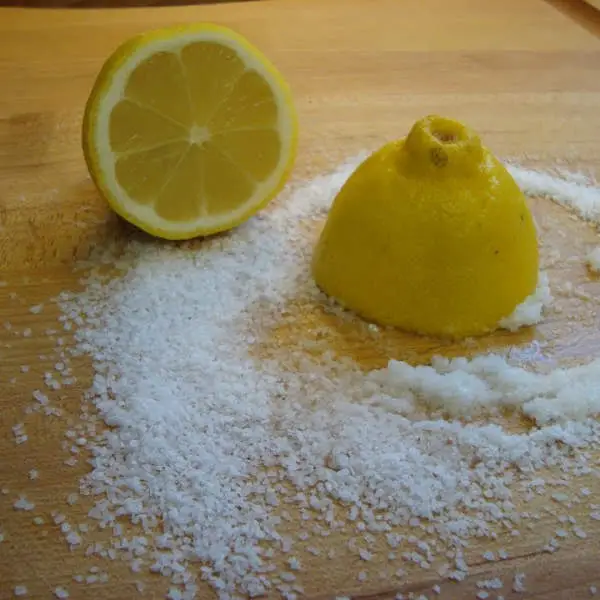
A great cleaner due to its high citric acid content.
It can kill bacteria and mold all while smelling great.
- Make a mixture of 1/2 water and 1/2 lemon juice
- Add to the reservoir
- Begin brewing
- Pause brewing and allow it to sit for an additional half-hour
- Resume brewing
- Repeat with just water until the water runs clear and the lemon juice smell is gone
- Alternatively, you can skip this step and brew yourself a cup of coffee with a hint of lemon
As you can see, there are many other natural ways to clean the insides of a coffee maker without bleach.
While it’s a great disinfectant for the outside and the carafe, the insides should be left to either vinegar, lemon juice, or baking soda.
Try them all and see which one is the best fit for you!
Set Your Calendar

In order to get the tastiest cup of coffee, it’s important to clean your coffee maker regularly.
So what does this mean?
Well, once a month is your best bet to decrease mineral buildup and prevent mold and bacteria from forming.
Mark it on the calendar, set a reminder on your phone, etc. Be sure to make this one of your kitchen priorities.
If you call yourself a coffee addict, this simple cleaning exercise will only enhance your morning cup.
Don’t Overdo it!
Now you know it’s important to clean your coffee pot not only for better-tasting coffee but also to keep out bacteria and mold.
In addition to cleaning the outside with bleach, there are many other nontoxic ways to keep your coffee maker free from grime and ready to serve up some great-tasting coffee.
📌 Pin Me for Later Reading! 📌
I recommend you save this pin to Cleaning Coffee Machines or Coffee Maker Cleaning Tips & Hacks or something similar.
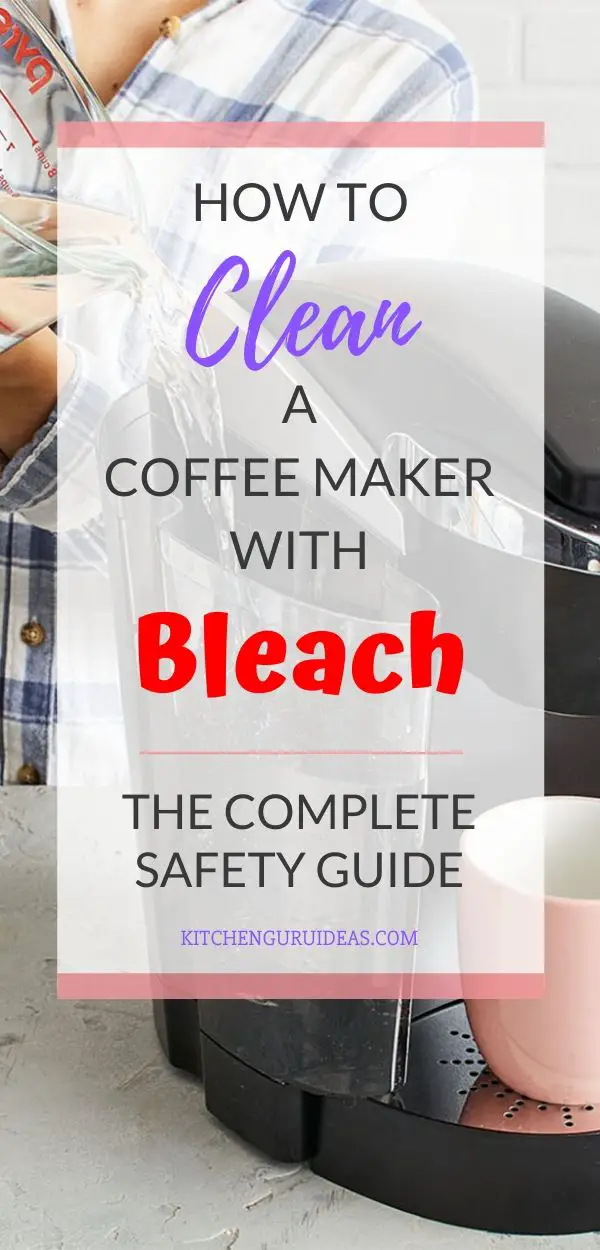
Do you use bleach for washing clothes? Tell me in the comments below.

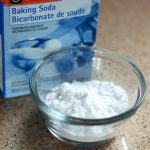
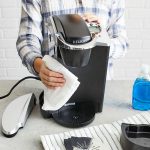


Be the first to comment